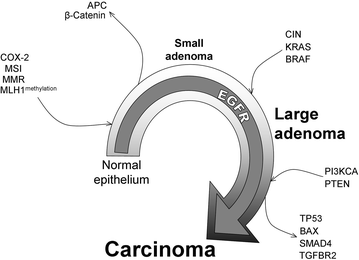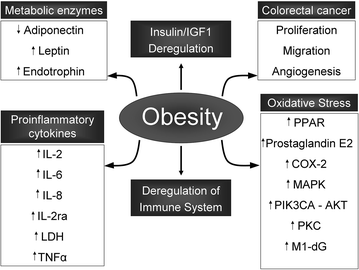Obesity and colorectal cancer: molecular features of adipose tissue
- PMID: 26801617
- PMCID: PMC4722674
- DOI: 10.1186/s12967-016-0772-5
Obesity and colorectal cancer: molecular features of adipose tissue
Abstract
The huge part of population in developed countries is overweight or obese. Obesity is often determined by body mass index (BMI) but new accurate methods and ratios have recently appeared to measure body fat or fat located in the intestines. Early diagnosis of obesity is crucial since it is considered an increasing colorectal cancer risk factor. On the one hand, colorectal cancer has been strongly associated with lifestyle factors. A diet rich in red and processed meats may increase colorectal cancer risk; however, high-fiber diets (grains, cereals and fruits) have been associated with a decreased risk of colorectal cancer. Other life-style factors associated with obesity that also increase colorectal cancer risk are physical inactivity, smoking and high alcohol intake. Cutting-edge studies reported that high-risk transformation ability of adipose tissue is due to production of different pro-inflammatory cytokines like IL-8, IL-6 or IL-2 and other enzymes like lactate dehydrogenase (LDH) and tumour necrosis factor alpha (TNFα). Furthermore, oxidative stress produces fatty-acid peroxidation whose metabolites possess very high toxicities and mutagenic properties. 4-hydroxy-2-nonenal (4-HNE) is an active compounds that upregulates prostaglandin E2 which is directly associated with high proliferative colorectal cancer. Moreover, 4-HNE deregulates cell proliferation, cell survival, differentiation, autophagy, senescence, apoptosis and necrosis via mitogen-activated protein kinase (MAPK), phosphoinositide 3-kinase (PIK3CA)-AKT and protein kinase C pathways. Other product of lipid peroxidation is malondialdehyde (MDA) being able to regulate insulin through WNT-pathway as well as having demonstrated its mutagenic capability. Accumulation of point mutation enables genomic evolution of colorectal cancer described in the model of Fearon and Vogelstein. In this review, we will summarize different determination methods and techniques to assess a truthfully diagnosis and we will explain some of the capabilities that performs adipocytes as the largest endocrine organ.
Figures


Similar articles
-
Associations of sedentary lifestyle, obesity, smoking, alcohol use, and diabetes with the risk of colorectal cancer.Cancer Res. 1997 Nov 1;57(21):4787-94. Cancer Res. 1997. PMID: 9354440
-
The mAb against adipocyte fatty acid-binding protein 2E4 attenuates the inflammation in the mouse model of high-fat diet-induced obesity via toll-like receptor 4 pathway.Mol Cell Endocrinol. 2015 Mar 5;403:1-9. doi: 10.1016/j.mce.2014.12.017. Epub 2015 Jan 14. Mol Cell Endocrinol. 2015. PMID: 25596549
-
Mechanisms linking obesity, inflammation and altered metabolism to colon carcinogenesis.Obes Rev. 2012 Dec;13(12):1083-95. doi: 10.1111/j.1467-789X.2012.01024.x. Epub 2012 Sep 3. Obes Rev. 2012. PMID: 22937964 Review.
-
Dietary flaxseed oil reduces adipocyte size, adipose monocyte chemoattractant protein-1 levels and T-cell infiltration in obese, insulin-resistant rats.Cytokine. 2012 Aug;59(2):382-91. doi: 10.1016/j.cyto.2012.04.004. Epub 2012 May 14. Cytokine. 2012. PMID: 22592037
-
Decoding cell death signals in liver inflammation.J Hepatol. 2013 Sep;59(3):583-94. doi: 10.1016/j.jhep.2013.03.033. Epub 2013 Apr 6. J Hepatol. 2013. PMID: 23567086 Review.
Cited by
-
Transcriptome Analysis of Subcutaneous Adipose Tissue from Severely Obese Patients Highlights Deregulation Profiles in Coding and Non-Coding Oncogenes.Int J Mol Sci. 2021 Feb 17;22(4):1989. doi: 10.3390/ijms22041989. Int J Mol Sci. 2021. PMID: 33671464 Free PMC article.
-
Stent experiences in emergency conditions in acute mechanical intestinal obstruction caused by colorectal cancer.Wideochir Inne Tech Maloinwazyjne. 2019 Jan;14(1):46-51. doi: 10.5114/wiitm.2018.76072. Epub 2018 May 30. Wideochir Inne Tech Maloinwazyjne. 2019. PMID: 30766628 Free PMC article.
-
Exploring the Influence of Age, Gender and Body Mass Index on Colorectal Cancer Location.Medicina (Kaunas). 2023 Jul 30;59(8):1399. doi: 10.3390/medicina59081399. Medicina (Kaunas). 2023. PMID: 37629689 Free PMC article.
-
Diet and exercise interventions for pediatric cancer patients during therapy: tipping the scales for better outcomes.Pediatr Res. 2018 Jan;83(1-1):50-56. doi: 10.1038/pr.2017.225. Epub 2017 Oct 25. Pediatr Res. 2018. PMID: 29068433 Free PMC article. Review.
-
Metabolically Healthy Obesity Is Associated with an Increased Risk of Colorectal Adenoma Occurrence Diagnosed by Surveillance Colonoscopy.Gut Liver. 2021 May 15;15(3):383-390. doi: 10.5009/gnl20084. Gut Liver. 2021. PMID: 32616681 Free PMC article.
References
-
- Arem H, Chlebowski R, Stefanick ML, Anderson G, Wactawski-Wende J, Sims S, et al. Body mass index, physical activity, and survival after endometrial cancer diagnosis: results from the Women’s Health Initiative. Gynecol Oncol. 2013;128(2):181–186. doi: 10.1016/j.ygyno.2012.10.029. - DOI - PMC - PubMed
Publication types
MeSH terms
LinkOut - more resources
Full Text Sources
Other Literature Sources
Medical
Miscellaneous

